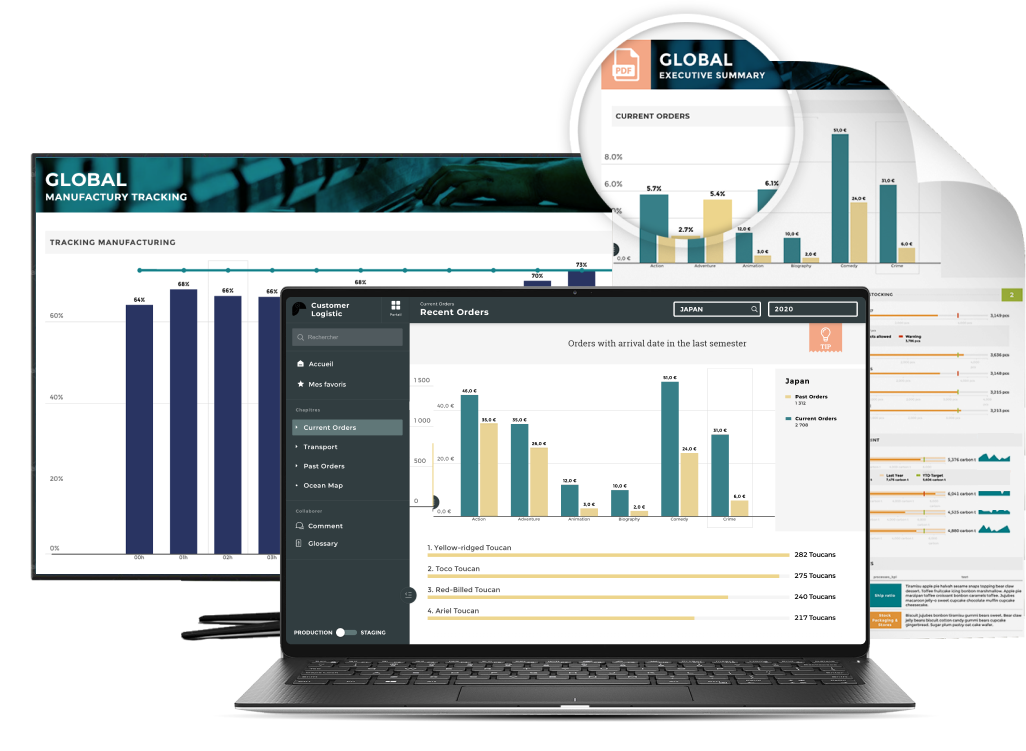With an increased societal focus on environmental, social, and operational responsibility, corporations have turned their attention to Environmental, Social, and Governance (ESG) initiatives to maintain transparency and improve their social standing.

As more corporations adopt these initiatives, spending substantial amounts of money to reduce waste, run diversity campaigns, and improve management practices, tracking progress to measure success has become an integral part of ESG best practices.
In this article, we take a look at some of the most important KPIs organizations should consider tracking to improve their ESG initiatives as well as how data storytelling can help bring them to life.
Environmental KPIs
Climate change is a big concern for businesses. According to a survey conducted by Deloitte Global, 91% of business executives said that their business felt the impact of climate change and 84% of them are personally concerned about the impact of climate change on their business. Because shareholders, customers, and potential investors also view the need for environmental protection, today's teams are all feeling the pressure to double-down on green initiatives.
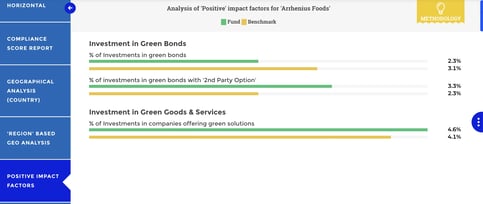
Here are (some of) the top KPIs ESG leaders are measuring to see how their business stack up against their goals:
- Energy Use per Facility
This has become one of the most important KPIs for companies with multiple locations to track compliance for environmental regulations. Instead of performing a calculation to track this KPI, many businesses elect to install RTUs, or rooftop units, that display current and daily electricity usage which surface an educated estimate of energy usage. An accurate measuring system to track energy usage is necessary to monitor this KPI.
- Expected Energy Saved to Actual Use
This ratio allows businesses to view their energy savings data from the perspective of set goals. The common benchmark for energy management is the ISO 50001 standard, against which most firms compare their energy usage. Businesses widely utilize this KPI to gauge whether certain changes made to their operations or infrastructure are contributing to meeting their environmental goals.
To calculate the values for this KPI, you can use the following formula:

- Carbon Footprint
This KPI has continued to gain traction in recent years. You're probably unsurprised to see it on this list as every major transportation, manufacturing, and logistics firm has set goals for reducing their carbon footprints.
A carbon footprint is the amount of carbon dioxide and other carbon compounds emitted by an individual, company, or country from the burning of fossil fuels. Because there are many variables in determining a business’s carbon footprint, companies such as TerraPass offer services that help to accurately measure this KPI.
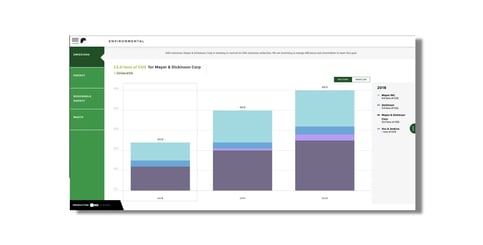
- Waste Management
Pollution and waste are also vital to advancing an ESG strategy. Currently 3.5 million tons of waste are omitted per day, with experts warning that this could exponentially increase in the near future. Although companies have been focusing on reducing operational waste, they are shifting their focus to understanding ways in which they can also limit consumer waste. Calculating this KPI varies from industry to industry, and the EPA recommends implementing measures such as:
-
- Hauler Records
- Purchasing Records
- Sales Records
- Employee Surveys
- Facility walkthroughs
- Waste sorting
- Nature Loss
- Freshwater Availability
As clean freshwater becomes an increasingly scarce resource, this KPI will be extremely important to track. To track Freshwater Availability, organizations measure the mega-litres of water they withdraw, mega-litres of water they consume, and the percentage of each in regions with high or extremely high baseline water stress.
- Resource circularity
In certain industries that draw on natural resources, such as manufacturing, resource availability and circularity are important metrics to measure the sustainability of operations. Metrics for this KPI include the Circular Transition Indicators and indicators developed by the Ellen MacArthur Foundation.
Tracking these measures can help businesses identify where waste can be eliminated or reduced and provide a more focused ESG strategy. Because environmental KPIs contain many complex measurements, terminology, and data sets, presenting them in dashboards that are easy to use and understand is vital. Tools like Toucan can help you update your KPIs in real-time, and design dashboards that are readable, versatile, and scalable.
KPIs
Social responsibility is a core requirement for today's businesses, helping ensure that products, services, and business practices positively impact the well-being of local and global communities. Social KPIs focus specifically on employee management, company culture, employee diversity, health, and safety. Here are some of the Social KPIs you can employ to effectively measure social responsibility:
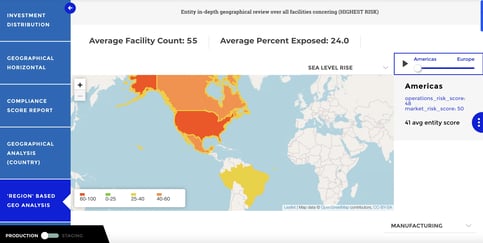
- Employee Diversity
Corporate diversity is among the most relevant Social KPIs to track. A recent Gartner study predicted that, by 2022, companies will exceed their financial objectives by as much as 75% if their teams have diversity and inclusion in the decision-making processes. This KPI has been a focus for investors, who view diversity as a metric for success.
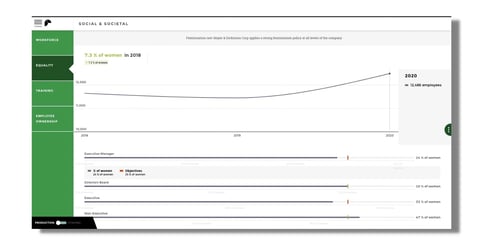
- Employee Health and Safety
Ensuring the health and safety of employees is vital when adopting, implementing, or adjusting any strong ESG strategy. Measuring things like incidents of injury and employee productivity can uncover strategies that improve location management, help overworked employees, and address flawed employee-related policies. Many corporations have begun to introduce mandatory health and safety training, options for employees to provide anonymous feedback on health and safety concerns, and measures to ensure that all equipment and facilities are up to date with industry standards. There are many ways to measure health and safety, including the number and rate of fatalities because of a work-related injury, recordable work-related injuries, and types of work-related injuries per hour worked. The ways you do so will be specific to your context.
- Consumer Responsiveness
Measuring consumer reactivity to a product or service is a great way to gauge how customers perceive your products or services and to then adjust (or maintain) your strategy in response. More than ever, corporations are looking to build positive relationships with consumers to improve offerings, attract investors, and build sustainable practices/products. Although there is no specific formula to measure consumer responsiveness, companies can employ surveys, review pages and a contact line to collect data. The important takeaway here is not the specific consumer responsiveness metric, but the importance of tracking it in a way that benefits your organization.
- Training provided
Given the importance of investing money into training new and existing employees, this KPI is essential to track for your ESG strategy. If training is lacking, efficiency, employee morale, and revenue will suffer as a result. One of the best ways to start tracking employee training is to measure how many average hours of training (per person) an organization’s employees have completed during a given period, and then subsequently look to understand how this has impacted other, more performance-based, KPIs.

- Pay equality
Employee pay, especially between genders, has become a larger focus for businesses in the past decade. Tracking pay for employees in similar positions can ensure that all employees are paid fairly based on merit. To calculate pay equality use the following formula:

- Rate of Employment
For evolving corporations, the rate of employment, especially locally, proves whether a given company is looking to positively impact the communities near its operations. To track this KPI, note the total number and rate of new employee hires during the reporting period, segmenting them by age, gender, or other priority differentiators.
- Economic Contribution
A firm’s impact on local, regional, and government economies is amongst the most important measures to track for ESG initiatives. High levels of transparency and a display of initiative can positively impact local communities economically and differentiate a firm for showing social responsibility. Many factors contribute to Economic Contribution, including:
Although not as complex as environmental KPIs, social ESG reporting necessitates a more intimate portrayal of your firm’s efforts. Posting all your metrics in written form to a PDF, for example, will not convey your KPIs in the same manner as a dashboard intentionally designed for social responsibility reporting. Guided tools such as Toucan can offer helpful design perks, including color-coding certain ethnic groups, genders, and age groups in reports to provide a clear, uncluttered social story.
Governance KPIs
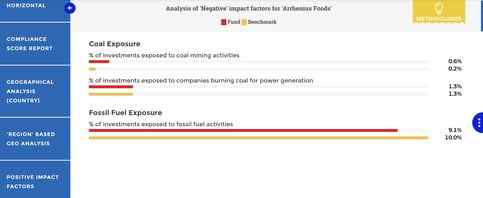
Corporate governance, put plainly, is the system by which companies are directed and controlled. So it follows that the KPIs here measure things like leadership, ethics, and management practices. Here are some KPIs you'll want to consider for measuring corporate governance:
- Operational and Financial Results
These KPIs are closely intertwined, with operations directly impacting a firm's financial position and vice versa. Because operations are usually managed by executives, any weaknesses in process efficiency usually signify uninformed or lacking decision-makers. Likewise, financial issues can represent the incompetence of financial management. The easiest way to measure these KPIs is to view the quarterly balance sheet and leverage tools that help measure operational efficiency.
- Executive compensation
The compensation of upper management is a critical measurement to ensure transparency. Implementing pay transparency practices, like disclosing all salaries and bonuses (including those of executives), helps employees feel as though they are being fairly compensated for their work. If a company is performing poorly, and executive salaries are rising, employees and consumers may also decide that their leaders are incompetent and move to a firm with more considerate and discretionary leadership.
- Mitigation
Risk is a major aspect to virtually anything in life, and business is no different. Although risk is normal, plans and processes that enable organizations to efficiently tackle problems must be instituted. Risk mitigation is most commonly measured through the formula:

- Anti-corruption
Mitigating corruption in your organization is one of the most important aspects of maintaining a favorable standing in the eyes of shareholders and future investors. Aspects anti-corruption monitoring include the total percentage of management that has received anti-corruption training, the total number of incidents relating to management corruption per reporting period, and meetings to discuss anti-corruption prevention in a firm’s culture.
- Integrated Risk and Opportunities
Tracking risks and opportunities over time can provide shareholders with a story of how your management views risk, and how opportunities are evolving in your firm. To track this KPI, take note of risk factors and opportunities that identify the company's principal material risks and opportunities. More specifically, examine an organization's appetite regarding these risks, how they evolve over time, and how they impact environmental and social issues.
- Material Issues Impacting Stakeholders
To ensure that all members of an organization are fairly represented and informed, tracking aspects of the company that directly affect stakeholders is an integral part of transparent reporting. Drafting a list of topics concerning key stakeholders, as well as how these topics evolved over time can create a more stable and favorable relationship between management and stakeholders.
- Protected Ethics Advice and Reporting Mechanisms
A disclosure and tracking of ethics programs and reporting mechanisms for violations, as well as their efficacies, can limit the effect of ethical breaches by any member of the team. To track this KPI, keep track of initiatives to seek advice from credible organizations on ethics programs and incidents of ethical breach reporting.
Governance KPIs are among some of the most difficult to report clearly, with technical jargon and quantitative measurements creating insights. Including a glossary page that your audience can scan to ensure a working understanding of your firm’s governance initiatives is important. Tools like Toucan help you clearly convey complex information to non-technical audiences, putting all members of your team on the same page.
How Data Storytelling Enables Better ESG tracking
ESG KPIs and reporting are an integral part of any business, providing insights, transparency, and confidence to shareholders. By measuring and reporting these KPIs, businesses can gain invaluable knowledge on where to expand, correct, or eliminate ESG initiatives.
A set of embedded dashboards that clearly and lucidly display your ESG data can eliminate the obstacles created by traditional KPI tracking, including
- Improved collaboration in the applications themselves
- Better data visualization
- Access to KPI dashboards on any device at any time
- Scalability
- Real-time insights
Toucan is a customer-facing analytics platform that empowers companies to drive engagement with data storytelling. Ranked the #1 easiest-to-use analytics solution by Gartner Peer Insights, their no-code, cloud-based platform cuts custom development costs with a quick and easy implementation, even for non-technical builders. To find out what our users say, read their reviews on Capterra.





